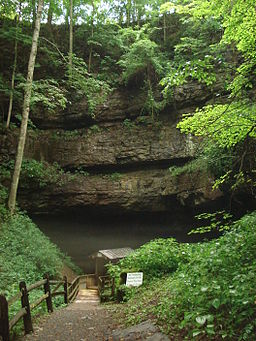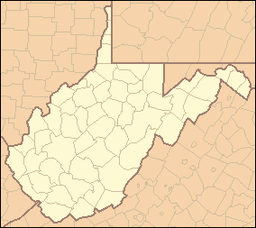- Organ Cave
-
Organ Cave System National Natural Landmark
National Register of Historic PlacesThe main historical (and commercial) entrance to Organ CaveCountry United States State West Virginia County Greenbrier Elevation 2,188 ft (666.9 m) Coordinates 37°43′05″N 80°26′13″W / 37.71806°N 80.43694°W Length 38.452 mi (62 km) [1] Designated NNL November 1973 [2] Owner Private owner IUCN category III - Natural Monument Nearest city Ronceverte, West Virginia Website: Organ Cave Organ Cave is a large and historic cave in Greenbrier County, West Virginia, USA. The surrounding community takes its name from the cave.[3]
In November 1973, the Organ Cave System — also known as the Organ-Hendricks Cave System[4] — was registered as a National Natural Landmark for being "the largest cave system in the State, containing many caves, one of which is Organ Cave. Noted also for its saltpeter troughs and vats." (It is now the second-longest known cave in the state, after the Friars Hole Cave System, in the same county.[1]) Organ Cave has also been listed on the National Register of Historic Places since 2005.[5][6]
Contents
History
Significant fossil discoveries bear witness to the early natural history of Organ Cave: giant ground sloth, grizzly bear, nine-banded armadillo, sabre-tooth cat, reindeer and an Ice Age porcupine.[7] Organ Cave's human history is attested by flint arrowheads used by early American Indians. Evidence of early white settlers in the cave is suggested by the date "1704" scratched on a wall, but this may be a later addition since the first white settlers to Greenbrier County came only in the 1740s.
The cave has been used since before 1835 as a source for nitre (saltpeter) for the manufacture of gunpowder. During the American Civil War, Confederate soldiers under the command of General Robert E. Lee again mined the cave for nitre. The cave today has the nation's largest collection of Civil War-era saltpeter hoppers.
Organ Cave was first surveyed by members of the National Speleological Society in July 1948. For many years it was considered the longest cave in the world. As of 28 April 2010[update], the Organ Cave System had 38.452 miles (61.882 km) of surveyed cave passage making it the 35th longest cave in the world, the 8th longest in the United States, and the 2nd longest in West Virginia.[1]
Jefferson's ground sloth
Formerly, a famous fossil discovery — that of Thomas Jefferson's giant ground sloth (Megalonyx jeffersonii) — had been assumed to have come originally from Organ Cave. Jefferson never visited the area and received the fossil from a local friend in 1796. In the early 20th century, a local man, Andrew Price of Marlinton, decided that the fossil had come from Organ Cave and popularized the theory.[8] In 1995, however, Smithsonian paleontologist Frederick Grady proposed[9] that Haynes Cave in nearby Monroe County was the true source. (His reasons had to do with historical land-ownership records.) The proprietors of Organ Cave, however, continue to insist on their property as the origin of the fossil in their interpretative exhibits and tour guide presentations.
See also
- List of National Natural Landmarks
- List of National Natural Landmarks in West Virginia
References
Citations
- ^ a b c Gulden, Bob (2009-03-16). "World's Longest Caves". CaverBob.com. Archived from the original on 2009-04-12. http://www.webcitation.org/5fzcaq0Zp. Retrieved 2009-04-13.
- ^ "Organ Cave System". National Natural Landmark, National Park Service website. http://www.nature.nps.gov/nnl/Registry/USA_Map/States/West%20Virginia/NNL/OCS/index.cfm.
- ^ A History Of Organ Cave Community
- ^ Davies, William E. (1958, 1965), Caverns of West Virginia, Geological and Economic Survey, Volume XIX A (with 1965 Supplement), West Virginia Geological Survey, pp 39, 41, 112; Supplement pg 22.
- ^ "National Register Information System". National Register of Historic Places. National Park Service. 2009-03-13. http://nrhp.focus.nps.gov/natreg/docs/All_Data.html.
- ^ The commercial website dedicated to Organ Cave, as well as commercial signage in the area, asserts that it is a National Historic Landmark. It is not. Charitably interpreted, the managers have mistaken listing on the National Register of Historic Places with designation as a NHL.
- ^ http://www.organcave.com/History.html
- ^ Humphreys, Blanche (1928), History of Organ Cave Community (Greenbrier County, West Virginia); Agricultural Extension Division.
- ^ Grady, Fred (1995), "The Search for the Cave from which Thomas Jefferson Described the Bones of the Megalonyx" [Abstract], In: "Selected Abstracts from the 1995 National Speleological Society National Convention in Blacksburg, Virginia"; In: Journal of Cave and Karst Studies, April 1997, pg 57.
Other sources
- Stevens, Paul J., editor (1988), Caves of the Organ Cave Plateau, Greenbrier County, West Virginia, Bulletin 9: West Virginia Speleological Survey; 200 pages (Over 70 devoted to Organ Cave); 80 pages of map (100 ft:1 inch) of the system; descriptions of 50 other caves on the Plateau.
- Humphreys, Blanche (1928), History of Organ Cave Community (Greenbrier County, West Virginia); Agricultural Extension Division.
External links
U.S. National Register of Historic Places in West Virginia Lists by county Barbour • Berkeley • Boone • Braxton • Brooke • Cabell • Calhoun • Clay • Doddridge • Fayette • Gilmer • Grant • Greenbrier • Hampshire • Hancock • Hardy • Harrison • Jackson • Jefferson • Kanawha • Lewis • Lincoln • Logan • Marion • Marshall • Mason • McDowell • Mercer • Mineral • Mingo • Monongalia • Monroe • Morgan • Nicholas • Ohio • Pendleton • Pleasants • Pocahontas • Preston • Putnam • Raleigh • Randolph • Ritchie • Roane • Summers • Taylor • Tucker • Tyler • Upshur • Wayne • Webster • Wetzel • Wirt • Wood • Wyoming

Other lists Keeper of the Register • History of the National Register of Historic Places • Property types • Historic district • Contributing property Categories:- Caves of West Virginia
- Geography of Greenbrier County, West Virginia
- Limestone caves
- Landmarks in West Virginia
- National Register of Historic Places listings in Greenbrier County, West Virginia
- National Natural Landmarks in West Virginia
- Show caves in the United States
- Visitor attractions in Greenbrier County, West Virginia
Wikimedia Foundation. 2010.




